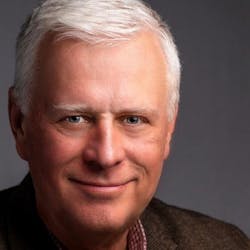Microgrid Adoption – Addressing Sustainability Goals While Growing the Job Market
Don Wingate, vice president of utility & microgrid solutions at Schneider Electric, explores how microgrids can help organizations meet their sustainability goals while also enabling job growth.
The energy landscape is changing – there’s no question about that. Throughout the US and around the world, we are facing numerous challenges as a direct result of climate change. We’re experiencing unprecedented power disruptions, be it from wildfires in the West, unprecedented weather in Texas, increased hurricanes in the Southeast or ice storms in the Northeast and Midwest states, and these disruptions are forcing industries to rethink previous ways of doing things in favor of more sustainable and resilient options.
Within the energy and electric industry, there are four crucial topics to address around climate change and energy transformation that impact businesses, homes, the workforce and our collective future.
The key issues: Cost, resiliency, reliability, sustainability
Cost is always a concern for both suppliers and customers. Cost has been continuing to rise exponentially over the past few years. In fact, according to the US Energy Information Administration, retail sales of electricity are expected to increase by 2.7% in 2021. As demand for energy increases, so does cost. This increasing cost per kilowatt hour plus the unpredictable energy demand charges across the US are expected to continue to steadily rise over the next few years.
As natural disasters, heat waves, wildfires and other climate issues continue to become more widespread, disaster response and recovery has placed resiliency at the forefront of today’s conversation around energy. These issues wreak havoc on communities throughout the world and have underscored the urgency for more resilient sources of energy.
Traditional utilities have been challenged to keep up with an increase in natural disasters, leaving many to seek alternatives to address their facilities’ resilience in times of need. The power grid is over 100 years old and aging infrastructure is further adding to the obstacles of the times – it’s time for a refresh. In the last year alone, over 3,500 outages have been experienced. It is widely acknowledged that disasters such as wildfires have occurred because of equipment failure.
In response to these challenges, we’ve seen an increase of sustainability mandates. Government legislator and regulatory agencies are now showing more interest and hold more influence over sustainability directives. Even leading investment banking firms are tying credit rating to companies being able to meet sustainability objectives. This has forced organizations to take a deeper dive into their impact on the environment, looking at what they can improve on, and, more importantly, how to define stricter environmental, social & governance (ESG) goals on which they will be held accountable. However, it’s left many with questions on how to move from setting goals to actually measuring and achieving these goals.
These issues can all be addressed with one vital solution.
The solution: Microgrid adoption
Microgrids are the missing piece to the puzzle many are looking for. Microgrids have been around for a long time and have evolved to become a valuable tool to assist in decentralizing the grid. A microgrid is an integrated energy system consisting of distributed energy resources that can be controlled as a single entity in parallel with the grid or in an intentional islanded mode.
Microgrids aid companies in cost control and predictability, drive resiliency, energy efficiency and sustainability. Utilizing microgrids for on-site and behind-the-meter generation of energy, companies can diversify their energy generation portfolio to meet sustainability needs and goals. Advanced microgrids also incorporate battery systems to store electricity, which, where allowed, can be sold back to the grid during peak demand or deployed during outages. Enabling a greater level of penetration for renewable energy with higher efficiency, microgrids provide energy savings, reliable power and a carbon footprint reduction at the same time. Microgrid technology is not new. It has successfully been deployed for decades in defense and other commercial applications. What is now new is that the cost to deploy is significantly improved, complexity is reduced with configurable systems, and cybersecurity is embedded for protection.
The technology of microgrids also supplies heightened stability and allows consumers to secure their own energy forms in time of need, moving them from reactive consumers to proactive prosumers (producers and consumers). Keeping power on at facilities during an outage is often crucial and can aid in several broad industry settings from hospitals to local farms. During the many crises facing our world today, microgrids are the fast, reliable and resilient solution when the traditional utility grid is down. Smaller microgrid designs are even able to serve residential or small commercial loads. They can also be configured for larger commercial properties such as shopping malls, neighborhoods or college campuses. By connecting small grids together or embedding them into larger ones, the possibilities are limitless. This is increasingly important as national leaders and governments seek ways to strengthen the electric grid and supply electricity to communities during natural disasters and crises. As energy demand (think “EV growth”) and supply evolve, opportunities unfold for communities, corporations, businesses and the workforce. There is still more work to be done to ease regulatory barriers and adjust traditional utility business models, but benefits and proven use cases are available today.
Advantage: Enabling job growth
Digital acceleration is here, and a more electric future is in sight, backed by microgrids. The market is changing – renewable energy businesses want to add more value with more sophisticated software for more effective uses of energy. Architects and design engineers are leveraging deeper skill sets to design smarter buildings with connected solutions that drive energy efficiency and sustainability for owners and occupants. And contractors and integrators need to bring wider expertise to implement these end-to-end solutions effectively. This translates into jobs. With skilled and proven partners driving new innovations throughout project phases, new jobs are created to fulfill the new proficiencies needed to execute these projects.
As more people gravitate toward a sustainable future, job growth is inevitable, and businesses must be prepared with the right foundation to satisfy an ambitious workforce. There is a rising desire among potential employees of prospective companies to be more sustainable, and a personal desire to “make the world a better place” – and many are now factoring this into their job search and ultimate career goals. Fulfilling this need for sustainable solutions often provides an employer with higher quality employees who have wide career options.
As the industry grows, the potential is vast. The workforce has more options – from health care and smart buildings to vertical farming and electric mobility – and new skill sets are needed in new and traditional sectors alike.
While traditional electrical and power engineering is always needed, there are many opportunities for individuals with backgrounds in digitization, IT, software, analytics, marketing, manufacturing and more. Schneider Electric, a leader in digital transformation and the No. 1 builder of microgrids in the world, has seen several use cases for those who don’t have a traditional engineering background.
For example, an indoor agriculture (vertical farming) customer has the need for agricultural talent who can also leverage analytics and run efficient process automation systems, along with an understanding of electrical systems. This combination of expertise allows the greenhouse to operate smoothly, powered by a microgrid, and is an opportunity for people to work at the intersection of green energy and cultivating sustainable food sources.
Different types of health care organizations have been faced with the highest requirements for indoor air quality. This means connecting solutions from HVAC to software to controls and monitoring, demanding operators with knowledge across various competencies.
Electric mobility providers need designers, builders, installers and integrators who each understand the connected system to make their solutions successful. Additionally, salespeople and marketers are needed to drive awareness of these solutions to bring them to businesses and homes.
Any organization seeking to gain control over energy costs, advance sustainability and increase resiliency can benefit from a microgrid. Adoption of microgrids is key in combating climate change, and early adopters have already seen the many benefits that come with it.
Don Wingate is vice president of utility & microgrid solutions at Schneider Electric. As one of the fastest growing sectors of Schneider Electric, microgrids are providing jobs across the country. With hundreds of successful projects in the US, the company is helping customers across diverse industries cut energy usage up to 30%. At the core of everything Schneider Electric does, microgrids drive solutions that support the digital transformation and acceleration needed for a more sustainable, resilient, efficient and electric future.







